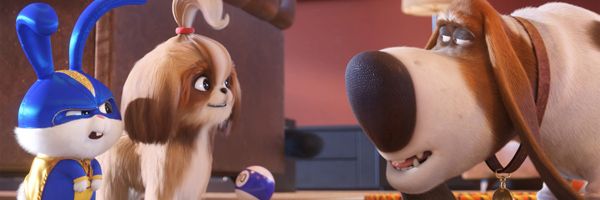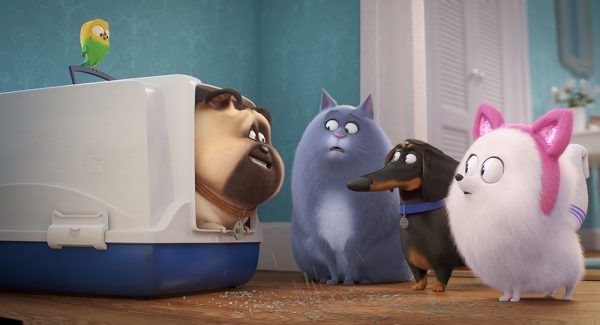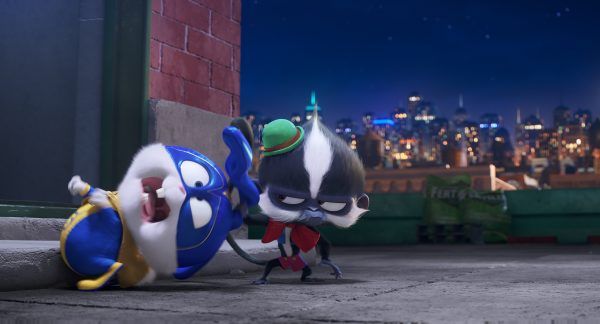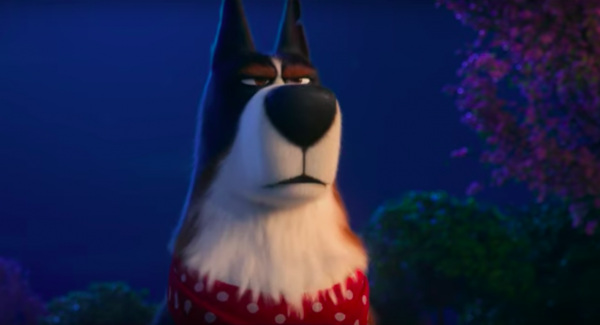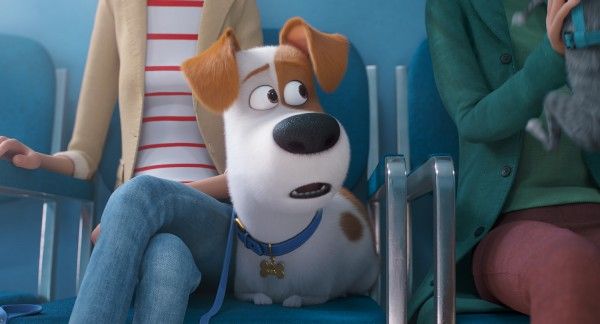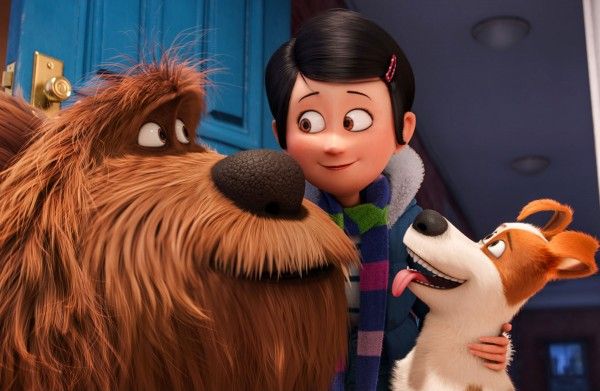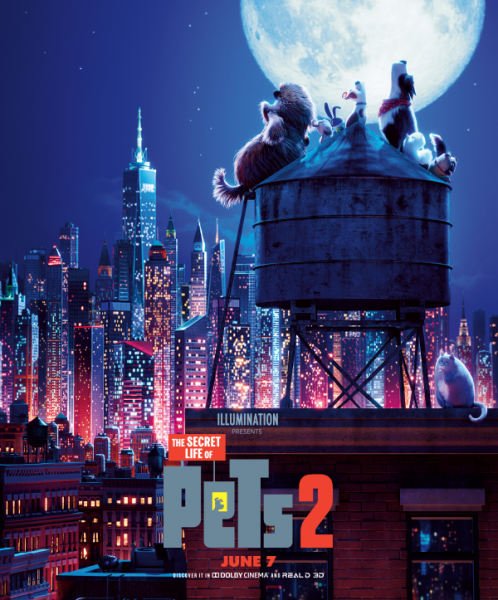The Secret Life of Pets 2, the highly anticipated sequel to the hugely successful 2016 animated feature that first explored the emotional lives of our pets, continues to follow Terrier Max (voiced by Patton Oswalt), as he copes with some major life changes that are making him a bit nervous and anxious. On this adventure, Max and his adopted canine brother and friend Duke (voiced by Eric Stonestreet) find themselves on a farm and face-to-face with a dog named Rooster (voiced by Harrison Ford), who helps Max find his own inner courage, while cat Chloe (voiced by Lake Bell), Pomeranian Gidget (voiced by Jenny Slate), bunny Snowball (voiced by Kevin Hart), Shih Tzu Daisy (voiced by Tiffany Haddish) and Basset Hound Pops (voiced by Dana Carvey) all have their own various levels of trouble to contend with. You can read Dave's positive review of the film here.
During this 1-on-1 phone interview with Collider, director Chris Renaud (who also directed the first film) talked about how it’s a dream come true to get to make these movies, when they realized that they’d be able to make a sequel, how the second film developed and evolved, how they got Harrison Ford involved, why Patton Oswalt made a good Max, Chloe’s scene-stealing moment, why it’s just impossible to be able to have this cast record their voice performances together, and how he’s ended up voices various characters himself. He also talked about where things are at with the Minions and Despicable Me franchises, for which he’s a producer.
Collider: How cool is it to get to make these movies, knowing that all ages can see and enjoy them, and that kids love them and these characters, and can’t seem to get enough of all of them?
CHRIS RENAUD: Quite simply, it’s really a dream come true for me. The things that I loved, as a kid, were things like Star Wars, and to be able to work on something and to help create something that the audience, whether they’re parents, or kids, or teenagers, really seem to embrace and have a good time with, has been so gratifying. I feel very fortunate to work with the team we’ve got, and to be able to contribute and make these movies.
These films are fun because it’s easy to find yourself wondering what your pets are doing when you’re not around, or what they’re thinking, at any given moment. Have you ever had pets, where you’ve really just wished that you could know what was going on in their head?
RENAUD: Yeah, certainly my two dogs. I had a dog, when I was a kid, and we have a dog now, and with a dog, you always look in their face and they really seem to emote. You’re like, “Are you thinking what I think you’re thinking, or are you just thinking about your next meal?” I’d like to believe that they’re thinking what I think they’re thinking. You’d like to think that, if your dog has an accident in the house and looks guilty, that they’re really feeling guilt.
The first film was a huge hit. When did you realize just how much people were loving that first film, and that getting to do a sequel was actually a real possibility?
RENAUD: Believe it or not, it was before the film came out. And the reason I say that is there was such a strong reaction to the first teaser that we put out, which really answered the question, in some ways, or at least was a peek behind the curtain of what your pets do when you’re not home. The response to that was just really astounding, so we started talking about ideas before the first Pets was even finished. You always try to create something that connects with people, and that’s either relatable or just something that they latch onto. It gets harder and harder, as there are more things competing for eyeballs. The fact that Pets was able to do that, it felt like we had something where we could go beyond even one film.
How big of an evolution did the sequel have? Does the film we see now resemble anything close to the conversations that you were having, when you started talking about what a sequel could be?
RENAUD: Yes and no. This isn’t a simple answer. We started with big ideas like, “Okay, let’s focus on pets and kids,” very early, which is Max’s theme. That big idea was where we felt there was some real opportunity, for the relatability for an audience. But the details of how to get there and how to tell that story, we went through a lot of versions of. We had discussions about, is Katie pregnant? Is the baby more of an impending problem, or is the baby born? Is it a baby, or is it a toddler? We went through a range of questions and how to answer them. And then, getting into the actual story, we knew that Max was nervous, early on, whether the baby was about to be born, or was already born. So, we took that nervousness and thought about a character that would be the counterpoint to that, which ended up being Rooster, on the farm. We went through many versions, but the farm just had such a clear contrast to Max’s life, as a pampered pet in the city, and was able to reinforce the theme of how it’s a dangerous world, but we’ve gotta live in it. Some of the big ideas were there, but how we made them work went through a lot of iterations, which is pretty typical for our process.
How did that farm conversation then evolve into having a dog named Rooster that would be voiced by Harrison Ford?
RENAUD: We wanted a taciturn cowboy, and a voice that goes along with that, that has authority, grit and authenticity. Who could do that better than Harrison Ford? A lot of comedy and drama is about locating contrast. If you look at Rooster, everything from the character design to the way he sounds is the complete opposite of Max and his nervous energy. Max shows up wearing a goofy cone, and Rooster is there with a cool bandana. Even in animation style, Rooster’s very slow and deliberate with no wasted movements, where Max is a bit more nervous energy. That’s how it evolves, in trying to strengthen the character dynamic.
But then, how did you go from an idea to actually getting Harrison Ford interested and willing to voice the character?
RENAUD: Well, it was easier than you might think. We went out to Harrison and just presented him the story. To be honest with you, I think it just connected with him. Some of those scenes, with letting your kids go, and knowing when that right time is, I think he just connected to it. He has a good sense of humor about himself. He’s such an icon, but he’s also able to have fun with it. The timing was really right for us and for him to work on this project together.
How did Tiffany Haddish get involved, and how did you end up pairing her with a character like Daisy?
RENAUD: With the character of Daisy, we basically needed somebody to come and recruit Snowball for a superhero mission. What’s great about Tiffany and what she embodies is attitude. She comes in looking for help, and then she sees the guy that she’s looking for, and he’s maybe not quite what she pictured. Her attitude is the perfect contrast with Snowball’s bravado. He’s slightly deluded with his capabilities, and she’s a great reality check for that character.
You not only have these new characters, but you also needed a new voice for Max, this time around. What was it like to work with Patton Oswalt on this, and what made him the right Max?
RENAUD: When we were recasting Max, we wanted to stay true to who the character that we had established, but obviously give it some new distinction with a new actor, and Patton easily inhabited the neurotic, hypersensitive Max that we’d established in the first movie, also with a bit of an acerbic to balance that out, particularly when he’s talking to Snowball. It was just about trying to find something that stayed true to the character that we’d established, but also giving it some distinction within that, and Patton just made it his own, instantly.
One of my favorite scenes in this, and one of the scenes that I’m sure will be a lot of people’s favorite scene, is Chloe really enjoying her catnip. How did that come about and evolve into what we see now?
RENAUD: Originally, when we had the scene, I think it was actually Max that came in asking for her help. The writer, Brian Lynch, had written a few ideas about what Chloe would be doing, and one of them was that she’d just ingested some catnip, and that was instantly everybody’s favorite. And then, we worked with the story team and played with different ideas. We knew that we had this idea where she was making weird cat sounds, so we had to dig up weird cat sounds. It evolved with the help of several people, as we developed from Brian’s original idea. What would Chloe be doing, when somebody comes through and asks for help? And then, we’d capture that in the animation, with her batting and swatting at the air, and her pupils getting huge, the way a cat does when they’re spaced out. We just brought all of those things together for the scene, along with the music. Using Jefferson Airplane was the quintessential catnip song. It reinforces the mood.
When you have such an incredibly talented cast, is it ever disappointing, as the director, that you have to work with them all individually and you don’t ever get to see them do their thing together?
RENAUD: In truth, no. It’s really a function of our process, versus not me wanting to see all of those talented people work together. The way animation works, it’s very iterative, over a long period of time. It can be 2 ½ years. So, it’s best for me, in the process, to get everybody comfortable with the fact that they’re going to be alone. Some people, like Kevin Hart for instance, have a schedule that’s so busy. I live in Paris – that’s where we make the movies – so I’d be up until midnight or one in the morning to record him in Australia. So, to get Kevin together with Patton [Oswalt] and Eric Stonestreet is never going to happen. I get everybody comfortable with recording alone, and then the editor, Tiffany Hillkurtz, gets an opportunity to put the material that we gather together into the scene. Truthfully, and I hope you would feel this way, you can’t tell that those people weren’t in the same room together. The conversation has a naturalism and a rhythm. That’s what we work to achieve.
Along with directing these films, you also voice Norman, the guinea pig. How did that come about, and what have you enjoyed about his journey through the films?
RENAUD: The way it came about is that, in the first movie, Norman’s storyline was based on my actual guinea pig, who got lost in our apartment. When we make a movie, we start with storyboards, which are drawings, and we often put temporary voices against the drawings, to build the scene and figure it out. So, I put my own voice on Norman, and the producer, Chris Meledandri, just liked the irony that I was voicing the guinea pig, since he was based on my guinea pig, and he said, “You should do the voice.” So, that was how it came about. My intention was that it would be temporary. And then, there are smaller characters that I voice, like the turkey. Basically, as we’re putting it together, I’ll go, “Okay, I have an idea,” and I’ll just run in and do it. That’s, very often, how things start. I’m all kinds of things in the movie. I’m a frog, and I’m the squirrel eating the corn. I just get an idea for a funny sound, and then I put it in there.
It seems as though there are endless possibilities for what you could do with this cast of characters. Are you hoping for a The Secret Life of Pets 3, or a TV series, or some way to keep the adventures of these characters going?
RENAUD: I love these characters, and I think it’s always fun, if the right opportunity comes along to keep them going. I feel a kinship with them, as one of the people who helped bring them to life. So, as long as people are enjoying spending time with the characters, it’s always a pleasure and an honor to keep thinking of new ideas and seeing what else we can do. One of the challenges with the very first film was that the idea is actually so open that we had to figure out, “Okay, how do we start this idea?” The thing you don’t want to lose is a relatability for the audience. They want to be able to see their own pet in it, to a certain degree. We all know that our pets aren’t running around, trying to stop racing freight trains, but things like the vet’s office or even the catnip scene keep it grounded, so that people really see their own animals in the characters.
You also work as producer on Minions and Despicable Me. How are things going with Minions 2? What are you doing to further those characters?
RENAUD: Well, as always with a sequel, we’re looking at ways to take them to new places. I can’t remember what’s been written and I don’t want to give away any plot details, but we’re always trying to find ways to take them to new places, both from a character point of view, but also from an environmental point of view, and introduce new characters. One of the great things about the Despicable series is introducing new villains or a new adversary. That’s always a lot of fun, thinking about that. We’ll have that stuff in Minions 2, as well.
Can we also expect to see a Despicable Me 4?
RENAUD: I never say never. I think we’ll have to see. We’ll get through Minions 2 first, and then we’ll see where we are. One of the nice things about the Despicable Me world, in particular, is that because it’s this guy and his family, and he’s got a job, there’s a lot you can do. Certain animated franchises are limited by the world they’re in or what the characters are. With Despicable, because they’re humans, you can take it anywhere. Not that we’d necessarily do this, but you could even have the girls grow up. There are a lot of places that you can take it, just because of the nature of the world and the characters themselves.
It seems like, out of all the characters in the films that you work on, the Minions would be the hardest to figure out how to develop story for because they’re not quite as verbal.
RENAUD: It’s tricky, but I think that’s why they work so well in the Despicable series. It all becomes about the human characters that you develop around them, to support them. That makes a big difference.
The Secret Life of Pets 2 opens in theaters on June 7th.

